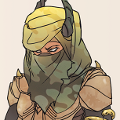 Dark Severance wrote:
Dark Severance wrote:Yes I know Zombicide is regions, but ultimately it is a square based game. The game board is a large area created by tiling square boards. You can't achieve that ease and modularity easily with hexes. When you use hexes you can't create a perfect square play area easily, it creates an odd shape, unless you create a border system for the hexes but even then lining them up with other pieces can be a pain. There are ways to make it work, but that means shrinking the tiles to a smaller size so if ultimately your final game board is 32"x32" then that is a lot of tiles to deal with vs simply having a few 12" or even 6-8" tiles. Another example is Super Dungeon Explorer, although also a region type game the boards itself is square based at the heart.
With battletech maps you could still combine them four ways, and with the range of maps that was never an issue, really. And the maps were rectangles anyway, so even if the hexes lined up the maps wouldn’t have

Nah, the issue with battle tech maps was more an issue with larger scale, outdoor maps. While maps based around cities (zombiecide) and spaceships (space crusade) can be combined in any way and remain fairly plausible, with rural landscapes it doesn’t really work that well. The canyon and mountain maps look silly next to desert maps, the desert maps look silly next to the forest maps, and almost every map looks silly next to a city map. As a result we tended to play the same groupings of maps with each other.
Anyway, just something else to keep in mind. I thought your point that unless your game needs more than four directions then there hexes only have drawbacks was a good point, and I just thought I’d expand on your mention of Battletech with a similar idea – mixing and matching maps can produce a lot of variety, but if the game’s setting and imagery doesn’t suit mix and match then it probably won’t be much use.